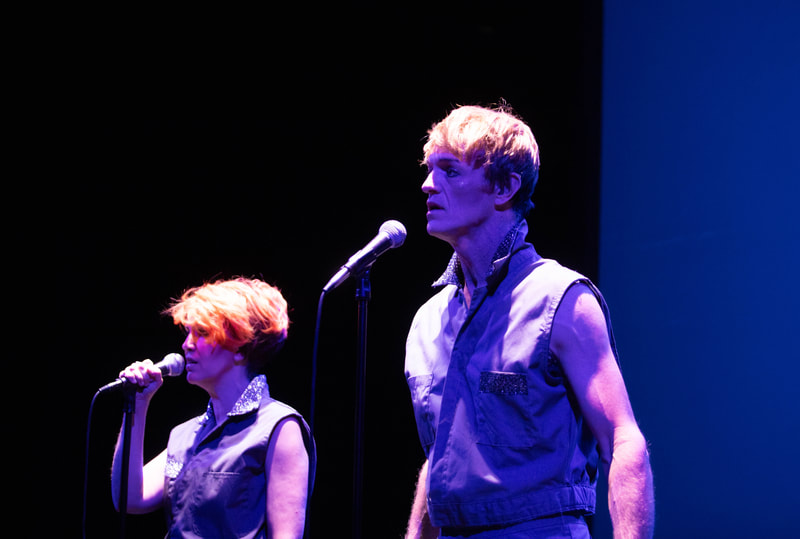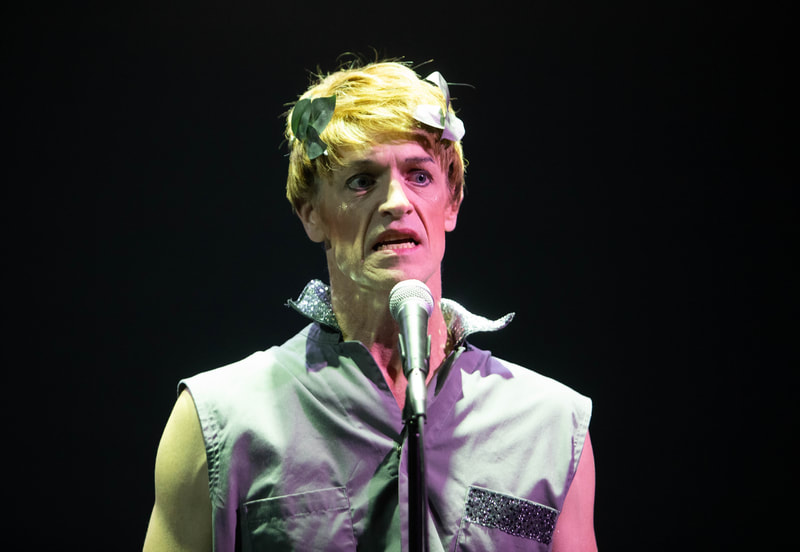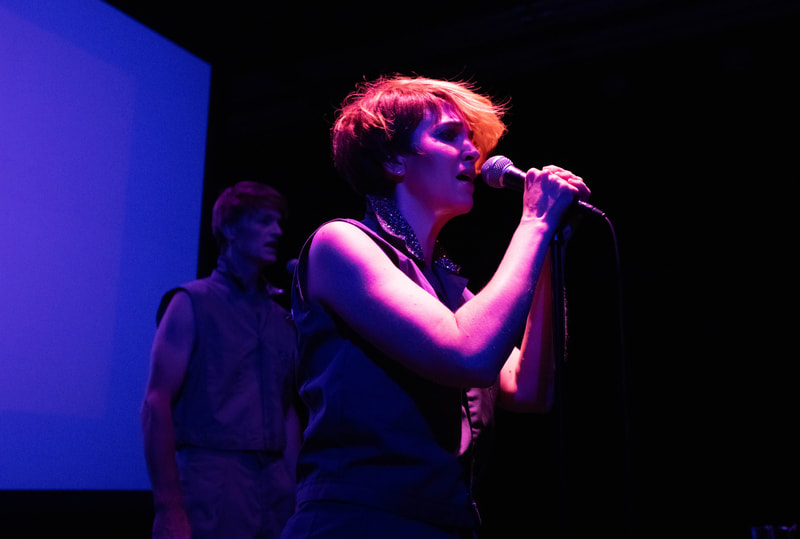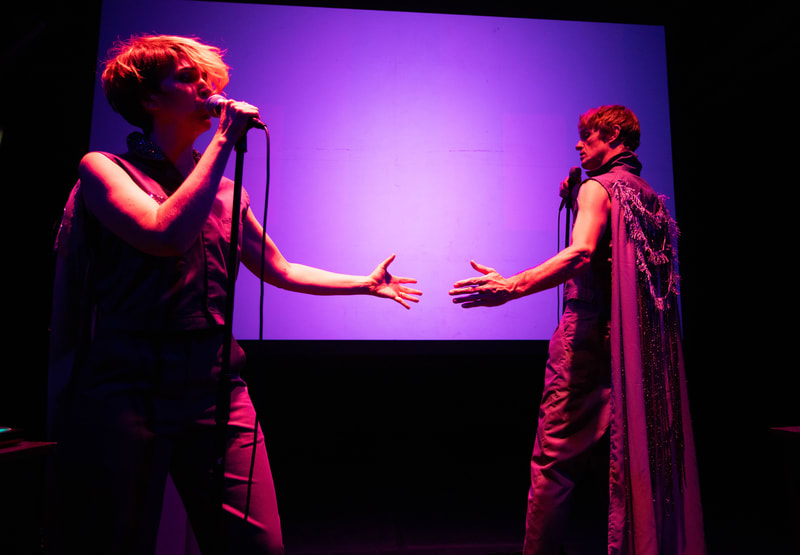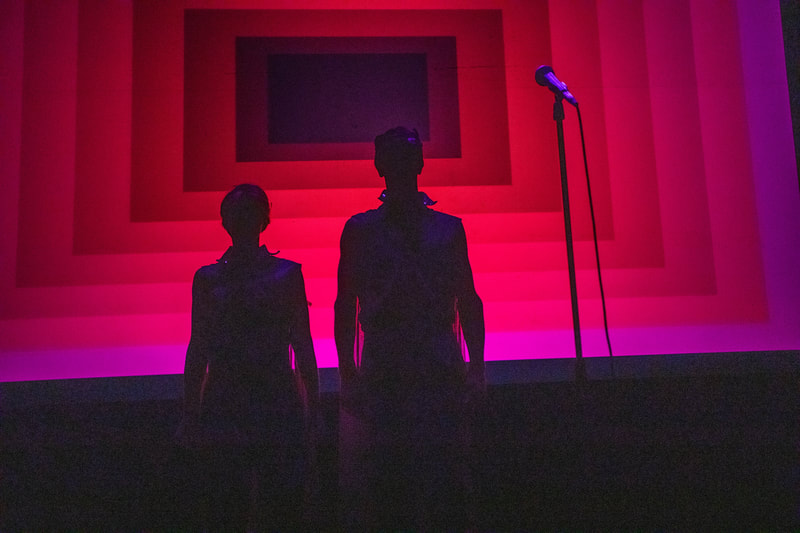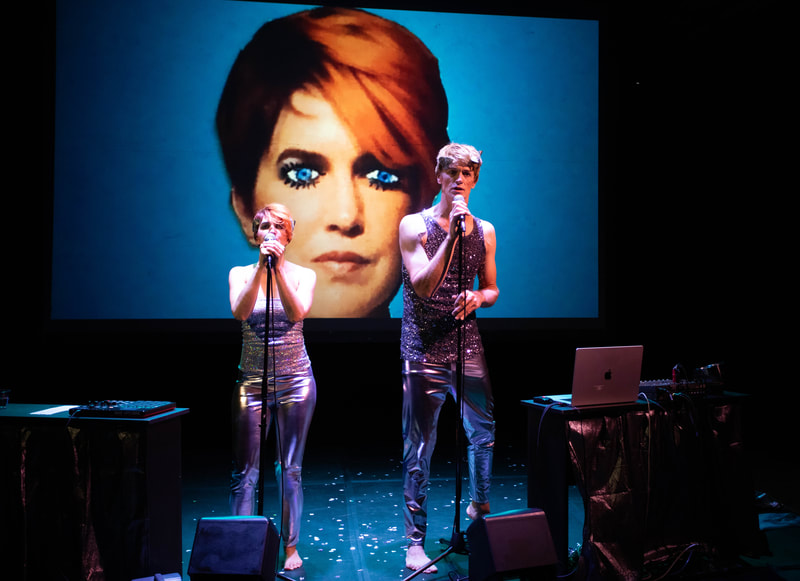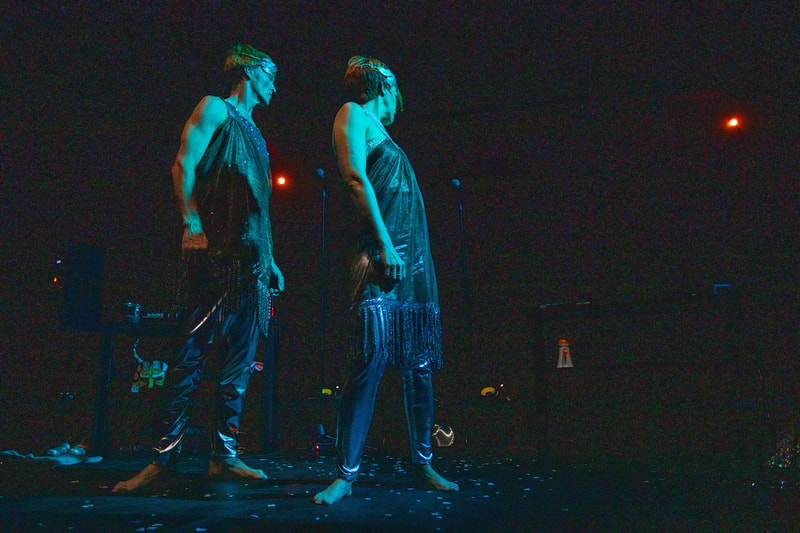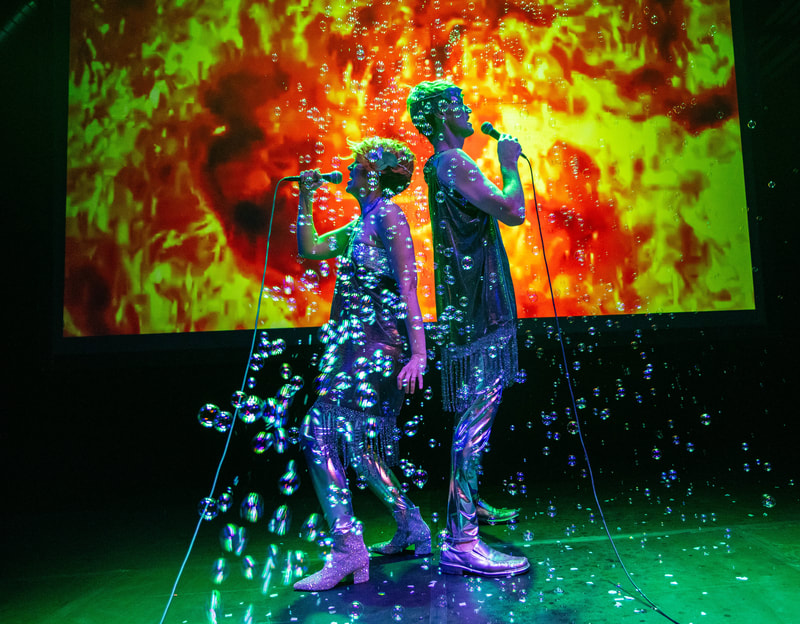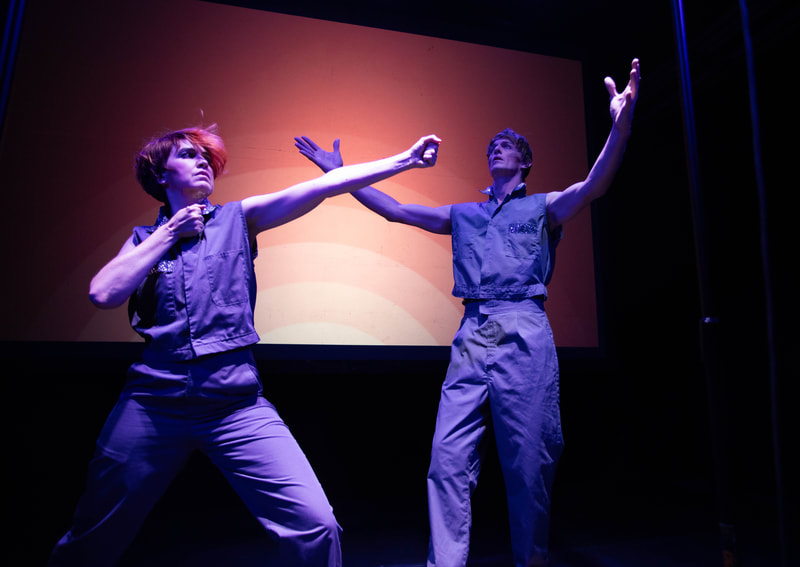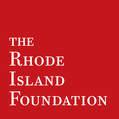Harvard University Artistic Producer and performer James Stanley and theater artist Jesse Hawley bring their celebrated transmedia performance work and faux-music history project to SPACE and on to the Wilbury Theatre Group with a NEFA touring grant.
In it, “legendary” pop-synth duo CVK (Clever and Vainglorious Kings) re-interpret the myths of Artemis and Apollo in a restaging of their 1986 theatrical concert tour “Extended Play.”
Hawley and Stanley’s project CVK: EXTENDED PLAY, inserts a fake band into the real history of ’80s new wave and consists of a full album of music, a faux historical essay and the band’s reunion tour.
In it, “legendary” pop-synth duo CVK (Clever and Vainglorious Kings) re-interpret the myths of Artemis and Apollo in a restaging of their 1986 theatrical concert tour “Extended Play.”
Hawley and Stanley’s project CVK: EXTENDED PLAY, inserts a fake band into the real history of ’80s new wave and consists of a full album of music, a faux historical essay and the band’s reunion tour.
CVK: EXTENDED PLAY
BY JESSE HAWLEY AND JAMES STANLEY
SPECIAL EVENT!
AUGUST 31 - SEPTEMBER 2
SPECIAL EVENT!
AUGUST 31 - SEPTEMBER 2
In 1986, the legendary, but short-lived new wave duo CVK (Clever and Vainglorious Kings) played their final show at the Orpheum Theater in Boston, Massachusetts. The band had produced only one four-song EP and two full-length records, and then disbanded as suddenly as they had come onto the scene. Though bypassed by critics in the ’80s, CVK achieved a cult status among audiences for their live shows, in which their musical performances were interwoven with political commentary, tales from their own personal narratives and (most quizzically) theatrical reenactments of Greek myths. By the release of their second and final album in 1985, the two had, in fact, assumed the characters of the Greek gods Artemis and Apollo, characters they would maintain both on and off the stage until their disbandment and subsequent disappearance the following year.
Starting at PVD (Providence) Fringe into the summer of 2023, CVK restage their 1986 concert tour, making good on their promise to “resume their roles as light-bringers in times darkness.”
With lighting and projections by Andy Russ and movement by Ali Kenner-Brodsky. CVK: Extended Play was developed with support from SPACE on Ryder Farm, Harvard’s ArtLab, and the Wilbury Theater Group in Providence, RI.
Starting at PVD (Providence) Fringe into the summer of 2023, CVK restage their 1986 concert tour, making good on their promise to “resume their roles as light-bringers in times darkness.”
With lighting and projections by Andy Russ and movement by Ali Kenner-Brodsky. CVK: Extended Play was developed with support from SPACE on Ryder Farm, Harvard’s ArtLab, and the Wilbury Theater Group in Providence, RI.
CVK: EXTENDED PLAY is funded in part by the New England States Touring program of the New England Foundation for the Arts, made possible with funding from the National Endowment for the Arts Regional Touring Program and the six New England state arts agencies.
ABOUT THE ARTISTS
Jesse Hawley and James Stanley did their first show together in 1997 in New York City and have been working together in theater, music and visual art ever since. From 2000 to 2017 they made immersive spectacles and material artifacts with the OBIE-winning collective National Theater of the United States of America (NTUSA)—including 8 shows, a book of poetry, a vinyl record and an illustrated acting manual. Their works toured nationally and internationally, and were recognized with multiple awards, grants and residencies including an OBIE, a Spalding Gray Award, two Henry Hewes Design Award Nominations and residencies at MacDowell, chashama, LMCC and SPACE at Ryder Farm. Meanwhile they performed (or otherwise collaborated) extensively with artists like Young Jean Lee, Richard Foreman, Mallory Catlett, Thomas Bradshaw, Phil Soltanoff, Normandy Sherwood, and Richard Maxwell. Since relocating to New England, they’ve continued their work together, mostly at the Wilbury Theater (House Warming, 2017; Olneyville Expo, 2019). Hawley teaches and directs in the Drama Department at the Tabor Academy and Stanley is Artistic Producer of Theater, Dance and Media at Harvard, where he teaches making theater from archival sources.
33 1/3:
Clever and Vainglorious Kings – Extended Play

Is it real? Is it faux? Can you explain the difference?
From August 29 - September 2 Harvard University Artistic Producer and performer James Stanley and theater artist Jesse Hawley bring their celebrated transmedia performance work and faux-music history project back to the Wilbury Theatre Group as part of a special tour.
Hawley and Stanley’s project inserts a fake band into the real history of ’80s new wave and consists of a full album of music, a faux 33 1/3 series historical essay and the band’s reunion tour.
In the project’s many forms, the “legendary” pop-synth duo CVK (Clever and Vainglorious Kings) re-interpret the myths of Artemis and Apollo in a re-staging of their 1986 theatrical concert tour “Extended Play.”
Listen to the album on Spotify, and keep reading below for the full reprinting of their (fake) “33 1/3” essay.
From August 29 - September 2 Harvard University Artistic Producer and performer James Stanley and theater artist Jesse Hawley bring their celebrated transmedia performance work and faux-music history project back to the Wilbury Theatre Group as part of a special tour.
Hawley and Stanley’s project inserts a fake band into the real history of ’80s new wave and consists of a full album of music, a faux 33 1/3 series historical essay and the band’s reunion tour.
In the project’s many forms, the “legendary” pop-synth duo CVK (Clever and Vainglorious Kings) re-interpret the myths of Artemis and Apollo in a re-staging of their 1986 theatrical concert tour “Extended Play.”
Listen to the album on Spotify, and keep reading below for the full reprinting of their (fake) “33 1/3” essay.
Extended Play
Richard Pricey, Jr.

BLOOMSBURY ACADEMIC LONDON • NEW YORK • OXFORD • NEW DEHLI • SYDNEY
Note: The following text is excerpted from a complete manuscript submitted to the ongoing 33 1/3 book series (Bloomsbury). This series asks authors to write about iconic and influential albums in the history of popular music. This submission was initially rejected by the editors due to the album’s obscurity. “Several of our readers remembered the band and were tempted by your critical narrative approach,” they wrote, “but none were convinced that this would make it as a point-of-sale purchase, which is frankly where most of our sales happen.” Bloomsbury has agreed to release this text for promotional purposes. The full manuscript is being withheld pending CVK’s promised return.
Dedicated to Amanda Finster and Mark Human. Thank you for bringing the light!
Note: The following text is excerpted from a complete manuscript submitted to the ongoing 33 1/3 book series (Bloomsbury). This series asks authors to write about iconic and influential albums in the history of popular music. This submission was initially rejected by the editors due to the album’s obscurity. “Several of our readers remembered the band and were tempted by your critical narrative approach,” they wrote, “but none were convinced that this would make it as a point-of-sale purchase, which is frankly where most of our sales happen.” Bloomsbury has agreed to release this text for promotional purposes. The full manuscript is being withheld pending CVK’s promised return.
Dedicated to Amanda Finster and Mark Human. Thank you for bringing the light!
On a rainy autumn night in October of 1980 in Manchester, England, a morose young punk who had just begun calling himself Mark Human gloomed about the entrance to the Ranch bar. The entrance to the Ranch was actually inside of another venue called Foo Foo’s Palace. And, this being his first visit to this or any hotspot on the punk scene, Human was a bit disoriented. The Ranch, a gay bar, and Foo Foo’s, a cabaret space, were both owned by former boxer and local drag artist Foo Foo Lammar. Over the last few years, the Ranch had become a home for the local punk scene whose members, more art-school than street tough, were routinely brutalized by the teddy-boys and hooligans who dominated Manchester’s working-class nightlife. But Human was not a local. Rather, he was a pilgrim.
Growing up in Leeds, some 45 miles away, Human had read about the Ranch in issues of the Manchester fan-zine City Fun, which were available at his local record store. In traveling to Manchester, Human was attempting a new start.
His name, which he had come up with on the bus ride down, was a nod to Gary Numan who had derived his own identity and aesthetic from the dystopian science fiction of which he was a fan. Human would borrow liberally from Numan’s playbook. But Human’s cyborg aesthetic would be more deeply informed by the alienation he felt as a spindly art kid growing up amidst post-industrial working class blight. Human had found respite in the expansive industrial sounds of Joy Division, whose records he owned, and had been deeply affected by lead singer Ian Curtis’s suicide several months earlier. But Human was equally inspired by scene leaders the Buzzcocks, who had issued a departure from punk’s three chord aggro-orthodoxy with up-beat sounding melodic pop songs which, nonetheless, expressed the isolation and dis-affectation that pervaded their generation. Still, Human’s first actual encounter with the famed epicenter of punk was disorienting. Having failed to check the trades, he had arrived on a night with no bands playing, during which the bar was filled with its gay clientele. Still, it was different than the pubs in Leeds. As it was above a drag bar, Human’s Bowie-inspired make-up raised no eyebrows, and he walked right in. But it took him a while to find the entrance to the bar downstairs. While there were no bands to see that night, Human’s visit to the Ranch would nonetheless prove fortuitous. For, another pilgrim had arrived in Manchester by train earlier that day and seemed just as disoriented as he was as the two sat side by side, like everyone else in the bar, sipping their Carlsberg Special Brews through a straw.
Amanda Finster had arrived in Manchester after leaving her home in Akron, Ohio – another city with a fading industrial past and a burgeoning music scene. But Finster didn’t take to the homegrown experimentalism of Akron bands like Devo. And she despised the dumb brutality and tired 4/4 meter of Stooge wanna-be’s like the Bizzaros. From the zines available in her hometown record stores, she had followed the trajectory of the art school punk quartet Wire and admired both the band’s scene mocking humor and their refusal to cultivate a rock and roll image. But she was no less interested in show boat iconoclasts like Prince and Hall & Oats, artists who were topping the charts by unabashedly funneling funk, doo-wop, disco and other hard rock no-no’s into their new pop sound.
The meeting of Human and Finster on that off-night at the Ranch Bar was relatively uneventful. Finster would later recall in an interview, “I don’t think we said too much. We might have made out for a little bit. But we definitely decided we would form a band. So we picked a name from some dumb book of Greek myths that I got in London.” (citation needed)
From that fortuitous meeting things moved rather quickly. Finster stayed in England and moved in with Human and his mother in Leeds. Within a few months the two had acquired instruments and had performed their first gig at a local party. The next month they travelled south to play at the Watford School of Art where a friend recorded their first song in a makeshift studio. By early 1981, they felt the band was on their way. But their legacy would long outlast the band itself.
CVK would only be active for five or so years, from their formation around in late 1980 to their abrupt disbandment in 1985. Their entire catalog would consist of only one four song EP and two studio albums, only the second of which is readily available (more on the first below). Their songs were never released as singles, and they never made any of the pop charts in either the UK or the US. There are no recordings of their live performances. They entirely missed the MTV train. And they were covered only fleetingly by serious critics, who treated them as more a theatrical curiosity than a serious band. What they did achieve in their time, however, was a cult following that would spread from the UK in 1981 to the US the following year. While hardcore punks deplored the band, and critics were focused on more “serious” fare, cadres of art school kids across two continents immediately took to their camp theatricality and pop art sensibility. In retrospect, one can place them in the interstitial space between the growing fields of new wave, performance art and avant-garde theater. And yet, their sudden disappearance left those who followed them to wonder not just where they were, but what they were to begin with. Was this all part of the act?
In terms of charting musical pop groups, CVK can be understood as just another no-hit wonder – an obscure and short-lived band among many equally obscure and short-lived bands of the post-punk era, bands who set out to change the world but quickly faded into the ether. This volume argues that they were something more: a multi-disciplinary arts group who, in their music, visual art and performance work, consistently trained their focus on the tension between art’s striving for longevity and pop’s drive toward ephemerality. Traces of this tension can be found in their song lyrics, sleeve art, show posters and other visual art that they made. But the most potent (and literal) example of this can be seen in the 1985 tour that ended their career, in which the duo took on the personae of the Greek gods Artemis and Apollo, lampooning the trope of the immortal rock god, and then just as suddenly disappeared.
“CVK were conceptual artists,” wrote cultural historian Stephen Duncombe, “Their whole venture was a lampoon of the industry they were trying to break into. But nobody knew if they meant it, and they were not very articulate about it. They were very sincere, which confused people. Nobody knew if it was a joke or not, and they either never let on, or were completely unaware of the joke they were making. The few times that people approached them, people who could really have helped them, who could have helped them to achieve the success that would have been the punchline to their joke, they pretty much walked away…. So, the art world eventually lost interest. And the industry did as well.” According to Duncombe, CVK anticipated and may even have provided inspiration for the KLF, the curious chart-topping band of the early 90s. KLF were conceptual artists masquerading as a new pop sensation. They first achieved popular (if not critical) success performing as the Timelords with a Doctor Who themed novelty song that rose to number one in the UK and New Zealand charts. They followed that with the publication of The Manual (How to Have a Number One the Easy Way) which instructed would-be pop stars to “go on the dole” and “get rid of your instruments.” Later, performing as KLF, they punked the British music industry when they closed an awards ceremony they were headlining by shooting machine guns (loaded with blanks) into the audience and left a slaughtered sheep outside of the ceremony’s afterparty. They followed this by deleting the full catalogue of their music and, most infamously, burning one million pounds sterling that they had earned from their music.
The KLF had engineered their own success in the music industry and then used that position to critique that same industry through a series of actions through which they gleefully destroyed everything that they had built. But the duo that conceived of KLF were industry insiders. Bill Drummond was a co-founder of Zoo Records and briefly managed Echo and the Bunnymen. He was also an A&R man for the Warner Music Group. KLF’s other half, Jimmy Cauty, began as a guitarist in the post-punk band Brilliant – famous mostly for its founding by Martin Glover who started it as a bitter offshoot of the perennially crumbling band Killing Joke, and for introducing Cauty to Drummond, who was their WEA manager.
CVK, on the other hand, were industry outsiders. They began their careers like so many other kids in the post-punk moment, as members of their respective local music scenes who took on punk’s DIY ethos and decided to start a band themselves. How they came together — he from the early goth inflected scenes of post-industrial England; she from the R&B inspired prog-rock underground of the American Midwest — is a story we will get to. And this story reveals much about the combination of influences that would come together in what would ultimately become the CVK sound. But it also reveals something about the politics of renown. And what it means to reach out toward fame, and what it means to achieve it or not. KLF’s lampoon of the industry only worked because they actually achieved pop success with a number one hit, then mocked their own achievements with a manual that claimed to show how anyone could do it. The joke required that they lay bare the machinations of the industry, and pull all of the hot air and mystery out of it. Their mocking was taken further through their references to the illuminati – the apocryphal organization the conspiracy-minded among us are convinced run everything.
CVK were no such masters. The best elements of CVK’s art – the music, the imagery, etc – were certainly by products of the same sort of experimentation. But CVK’s field of play was not the industry as it was with KLF. It was the culture and the community of the clubs they played. One of the few critics who covered their work in the mid 80s describe it as a product of “the wanderlust of two lost kids looking for a scene and a sound.” (citation needed) This kind of lazy, cliched commentary not only demeans the art and the scene these artists created, it infantilizes the whole enterprise by playing into tropes of dreamy-eyed artists as perennial outsiders whose act of creation is merely a reprocessing of the culture at hand. Reprocessing, it certainly was. Regurgitation might even be a more appropriate descriptor. But the art CVK created was definitely conscious, and it was definitely new. And their disappearance, far from indicating a failure of their project, should more properly be considered a constituent part. That’s what this book hopes to explore.
If you’re reading this, it’s probably because you’ve heard of the band, even if you don’t actually own any of their records. Or you’re binge-reading histories in the microcosm of this particular branch of music history, brought to light by some Spotify algorithm. That’s not a judgement. And, anyway, who am I to judge your motivations? But if you’re still reading it’s because you believe, at least to some extent, in the power of art and ephemerality and how they influence the machinations of fame and celebrity. And this is, in fact, a lens through which you can view most of art history. Things great. Things small. And things no longer there.
Growing up in Leeds, some 45 miles away, Human had read about the Ranch in issues of the Manchester fan-zine City Fun, which were available at his local record store. In traveling to Manchester, Human was attempting a new start.
His name, which he had come up with on the bus ride down, was a nod to Gary Numan who had derived his own identity and aesthetic from the dystopian science fiction of which he was a fan. Human would borrow liberally from Numan’s playbook. But Human’s cyborg aesthetic would be more deeply informed by the alienation he felt as a spindly art kid growing up amidst post-industrial working class blight. Human had found respite in the expansive industrial sounds of Joy Division, whose records he owned, and had been deeply affected by lead singer Ian Curtis’s suicide several months earlier. But Human was equally inspired by scene leaders the Buzzcocks, who had issued a departure from punk’s three chord aggro-orthodoxy with up-beat sounding melodic pop songs which, nonetheless, expressed the isolation and dis-affectation that pervaded their generation. Still, Human’s first actual encounter with the famed epicenter of punk was disorienting. Having failed to check the trades, he had arrived on a night with no bands playing, during which the bar was filled with its gay clientele. Still, it was different than the pubs in Leeds. As it was above a drag bar, Human’s Bowie-inspired make-up raised no eyebrows, and he walked right in. But it took him a while to find the entrance to the bar downstairs. While there were no bands to see that night, Human’s visit to the Ranch would nonetheless prove fortuitous. For, another pilgrim had arrived in Manchester by train earlier that day and seemed just as disoriented as he was as the two sat side by side, like everyone else in the bar, sipping their Carlsberg Special Brews through a straw.
Amanda Finster had arrived in Manchester after leaving her home in Akron, Ohio – another city with a fading industrial past and a burgeoning music scene. But Finster didn’t take to the homegrown experimentalism of Akron bands like Devo. And she despised the dumb brutality and tired 4/4 meter of Stooge wanna-be’s like the Bizzaros. From the zines available in her hometown record stores, she had followed the trajectory of the art school punk quartet Wire and admired both the band’s scene mocking humor and their refusal to cultivate a rock and roll image. But she was no less interested in show boat iconoclasts like Prince and Hall & Oats, artists who were topping the charts by unabashedly funneling funk, doo-wop, disco and other hard rock no-no’s into their new pop sound.
The meeting of Human and Finster on that off-night at the Ranch Bar was relatively uneventful. Finster would later recall in an interview, “I don’t think we said too much. We might have made out for a little bit. But we definitely decided we would form a band. So we picked a name from some dumb book of Greek myths that I got in London.” (citation needed)
From that fortuitous meeting things moved rather quickly. Finster stayed in England and moved in with Human and his mother in Leeds. Within a few months the two had acquired instruments and had performed their first gig at a local party. The next month they travelled south to play at the Watford School of Art where a friend recorded their first song in a makeshift studio. By early 1981, they felt the band was on their way. But their legacy would long outlast the band itself.
CVK would only be active for five or so years, from their formation around in late 1980 to their abrupt disbandment in 1985. Their entire catalog would consist of only one four song EP and two studio albums, only the second of which is readily available (more on the first below). Their songs were never released as singles, and they never made any of the pop charts in either the UK or the US. There are no recordings of their live performances. They entirely missed the MTV train. And they were covered only fleetingly by serious critics, who treated them as more a theatrical curiosity than a serious band. What they did achieve in their time, however, was a cult following that would spread from the UK in 1981 to the US the following year. While hardcore punks deplored the band, and critics were focused on more “serious” fare, cadres of art school kids across two continents immediately took to their camp theatricality and pop art sensibility. In retrospect, one can place them in the interstitial space between the growing fields of new wave, performance art and avant-garde theater. And yet, their sudden disappearance left those who followed them to wonder not just where they were, but what they were to begin with. Was this all part of the act?
In terms of charting musical pop groups, CVK can be understood as just another no-hit wonder – an obscure and short-lived band among many equally obscure and short-lived bands of the post-punk era, bands who set out to change the world but quickly faded into the ether. This volume argues that they were something more: a multi-disciplinary arts group who, in their music, visual art and performance work, consistently trained their focus on the tension between art’s striving for longevity and pop’s drive toward ephemerality. Traces of this tension can be found in their song lyrics, sleeve art, show posters and other visual art that they made. But the most potent (and literal) example of this can be seen in the 1985 tour that ended their career, in which the duo took on the personae of the Greek gods Artemis and Apollo, lampooning the trope of the immortal rock god, and then just as suddenly disappeared.
“CVK were conceptual artists,” wrote cultural historian Stephen Duncombe, “Their whole venture was a lampoon of the industry they were trying to break into. But nobody knew if they meant it, and they were not very articulate about it. They were very sincere, which confused people. Nobody knew if it was a joke or not, and they either never let on, or were completely unaware of the joke they were making. The few times that people approached them, people who could really have helped them, who could have helped them to achieve the success that would have been the punchline to their joke, they pretty much walked away…. So, the art world eventually lost interest. And the industry did as well.” According to Duncombe, CVK anticipated and may even have provided inspiration for the KLF, the curious chart-topping band of the early 90s. KLF were conceptual artists masquerading as a new pop sensation. They first achieved popular (if not critical) success performing as the Timelords with a Doctor Who themed novelty song that rose to number one in the UK and New Zealand charts. They followed that with the publication of The Manual (How to Have a Number One the Easy Way) which instructed would-be pop stars to “go on the dole” and “get rid of your instruments.” Later, performing as KLF, they punked the British music industry when they closed an awards ceremony they were headlining by shooting machine guns (loaded with blanks) into the audience and left a slaughtered sheep outside of the ceremony’s afterparty. They followed this by deleting the full catalogue of their music and, most infamously, burning one million pounds sterling that they had earned from their music.
The KLF had engineered their own success in the music industry and then used that position to critique that same industry through a series of actions through which they gleefully destroyed everything that they had built. But the duo that conceived of KLF were industry insiders. Bill Drummond was a co-founder of Zoo Records and briefly managed Echo and the Bunnymen. He was also an A&R man for the Warner Music Group. KLF’s other half, Jimmy Cauty, began as a guitarist in the post-punk band Brilliant – famous mostly for its founding by Martin Glover who started it as a bitter offshoot of the perennially crumbling band Killing Joke, and for introducing Cauty to Drummond, who was their WEA manager.
CVK, on the other hand, were industry outsiders. They began their careers like so many other kids in the post-punk moment, as members of their respective local music scenes who took on punk’s DIY ethos and decided to start a band themselves. How they came together — he from the early goth inflected scenes of post-industrial England; she from the R&B inspired prog-rock underground of the American Midwest — is a story we will get to. And this story reveals much about the combination of influences that would come together in what would ultimately become the CVK sound. But it also reveals something about the politics of renown. And what it means to reach out toward fame, and what it means to achieve it or not. KLF’s lampoon of the industry only worked because they actually achieved pop success with a number one hit, then mocked their own achievements with a manual that claimed to show how anyone could do it. The joke required that they lay bare the machinations of the industry, and pull all of the hot air and mystery out of it. Their mocking was taken further through their references to the illuminati – the apocryphal organization the conspiracy-minded among us are convinced run everything.
CVK were no such masters. The best elements of CVK’s art – the music, the imagery, etc – were certainly by products of the same sort of experimentation. But CVK’s field of play was not the industry as it was with KLF. It was the culture and the community of the clubs they played. One of the few critics who covered their work in the mid 80s describe it as a product of “the wanderlust of two lost kids looking for a scene and a sound.” (citation needed) This kind of lazy, cliched commentary not only demeans the art and the scene these artists created, it infantilizes the whole enterprise by playing into tropes of dreamy-eyed artists as perennial outsiders whose act of creation is merely a reprocessing of the culture at hand. Reprocessing, it certainly was. Regurgitation might even be a more appropriate descriptor. But the art CVK created was definitely conscious, and it was definitely new. And their disappearance, far from indicating a failure of their project, should more properly be considered a constituent part. That’s what this book hopes to explore.
If you’re reading this, it’s probably because you’ve heard of the band, even if you don’t actually own any of their records. Or you’re binge-reading histories in the microcosm of this particular branch of music history, brought to light by some Spotify algorithm. That’s not a judgement. And, anyway, who am I to judge your motivations? But if you’re still reading it’s because you believe, at least to some extent, in the power of art and ephemerality and how they influence the machinations of fame and celebrity. And this is, in fact, a lens through which you can view most of art history. Things great. Things small. And things no longer there.

